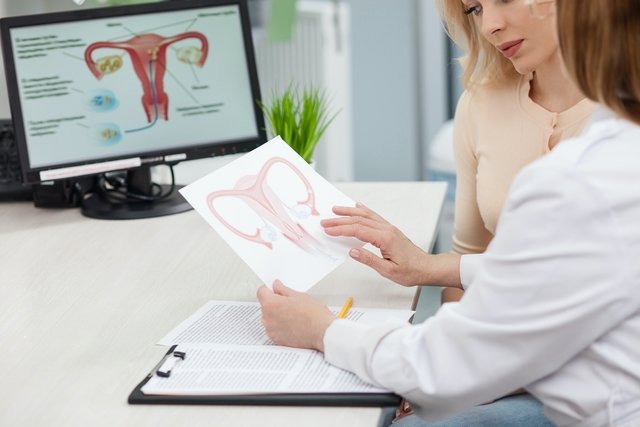Retroverted uterus is when the uterus is curved backwards, towards the spine and straight, and not forwards over the bladder, which can cause symptoms such as vaginal or back pain during intimate contact or painful menstruation.
However, in most cases, a retroverted uterus, also called an inverted or reversed uterus, does not cause symptoms and is discovered on routine imaging tests. Furthermore, this type of uterus does not affect fertility or pregnancy.
The treatment of a retroverted uterus is carried out by a gynecologist, but it is not always necessary, as it is a very common anatomical change, but if it causes symptoms, treatment with the placement of a uterine pessary or surgery, for example, may be indicated.

Retroverted uterus symptoms
The main symptoms of a retroverted uterus are:
- Painful menstruation;
- Vaginal or back pain during intimate contact, or in certain positions;
- Urinary infections;
- Sensation of pressure in the bladder;
- Mild urinary incontinence;
- Pain when urinating and evacuating;
- Pain in the hips or lower back.
Furthermore, one of the signs that may indicate a retroverted uterus is difficulty inserting tampons or menstrual cups.
However, a retroverted uterus in most women does not cause symptoms and is discovered during routine examinations such as a pelvic exam or ultrasound.
How to confirm the diagnosis
The diagnosis of an inverted uterus is made by the gynecologist through evaluation of symptoms, health history and gynecological pelvic examination, in which the doctor can feel the location of the uterus.
Make an appointment with a gynecologist in the nearest region:
Taking care of your health has never been easier!
Additionally, your doctor should order a transvaginal or pelvic ultrasound exam to confirm the diagnosis and rule out other conditions with similar symptoms, such as endometriosis or uterine fibroids.
Possible causes
The retroverted uterus is caused by a variation in the pelvic anatomy and may be present from birth, develop as the uterus matures or due to some health conditions.
The main causes of a retroverted uterus are:
- Genetics;
- Endometriosis;
- Fibroids;
- Pelvic inflammatory disease (PID);
- History of pelvic surgeries;
- Menopause.
Furthermore, a retroverted uterus can also occur due to a previous pregnancy, as after childbirth the muscles and ligaments of the pelvic floor may become looser, and the uterus may change position.
What are the chances of getting pregnant with a retroverted uterus?
A retroverted uterus does not cause infertility or make pregnancy difficult, nor does it prevent the development of a normal pregnancy.
However, if caused by a health condition such as endometriosis, in some cases it can make pregnancy difficult, but not because the uterus is retroverted, but because endometriosis is one of the causes of infertility.
Furthermore, in the case of uterine fibroids, depending on the size and position of the fibroid, it may also be difficult to get pregnant.
Retroverted uterus and pregnancy
A retroverted uterus during pregnancy can cause urinary incontinence, back pain or pain when urinating or having a bowel movement, which are common symptoms in most pregnancies.
Furthermore, the retroverted uterus does not prevent normal birth, as in most cases, until the 12th week of pregnancy, the uterus adopts a position closer to normal, facing forward and remaining under the bladder.
What does a pregnant belly look like with a retroverted uterus?
A pregnant belly with a retroverted uterus is normal, since as it grows the uterus returns to its normal position, becoming straight.
How the treatment is carried out
The treatment of a retroverted uterus must be guided by a gynecologist, who can recommend a specific treatment according to its cause, as in the case of endometriosis, uterine fibroids or pelvic inflammatory disease, for example.
However, treatment is not always necessary, especially when it is not caused by any health condition.
Some treatments that may be recommended by your doctor are:
1. Kegel Exercises
Kegel exercises may be recommended by the gynecologist for a retroverted uterus as they help to work the pelvic floor muscles, strengthening the muscles and ligaments, which can help the uterus return to its normal position or flexed anterior position. Learn how to do Kegel exercises.
2. Pessary
The pessary is a plastic or silicone device, inserted into the vagina by the gynecologist, to provide support for the uterus, which helps the uterus to remain in the anterior position, that is, facing forward and over the bladder. See more about the pessary and how to use it.
3. Surgery
In some cases, especially when a woman experiences pain, the doctor may recommend uterine repositioning surgery or uterine suspension to correct the position of the uterus in order to eliminate the pain.
Generally, this surgery is performed via laparoscopy, but it can also be performed traditionally with a cut in the abdomen or even intravaginally. Find out how videolaparoscopy is performed.
Possible complications
A retroverted uterus does not usually cause complications, however, during pregnancy if the uterus does not return to its normal or anteverted position, the uterus may become trapped within the pelvis.
This condition is known as incarceration of the uterus, and causes symptoms such as abdominal pain, constipation, pressure in the rectum, urinary retention or incontinence, and generally appears between weeks 14 and 16 of pregnancy.
Incarceration of the uterus is a rare complication, but can result in:
- Spontaneous abortion in the 1st or 2nd trimester of pregnancy;
- Fetal growth restriction;
- Fetal death;
- Uterine ischemia;
- Uterine rupture or premature birth in the 2nd or 3rd trimester.
Additionally, an incarcerated uterus can cause a woman to have a ruptured bladder, kidney failure, vaginal or bladder injury during childbirth, venous thrombosis or pulmonary embolism after childbirth, or an increased risk of uterine incarceration in another pregnancy.

Sign up for our newsletter and stay up to date with exclusive news
that can transform your routine!
Warning: Undefined array key "title" in /home/storelat/public_html/wp-content/plugins/link-whisper-premium/templates/frontend/related-posts.php on line 12
Warning: Undefined array key "title_tag" in /home/storelat/public_html/wp-content/plugins/link-whisper-premium/templates/frontend/related-posts.php on line 13



